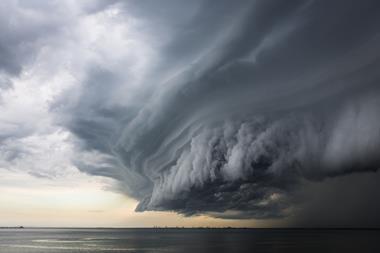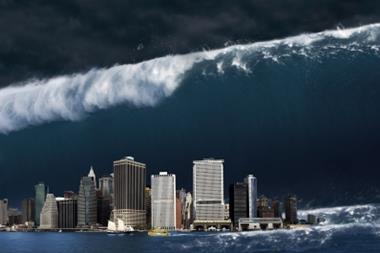In some areas we have seen the earthquake insurance market develop considerably; in others the status quo has changed very little. However, when we turn our attention back to the situation in the Japanese market in 1995 prior to deregulation, we swiftly observe that it was rather different from the present state of affairs. For a start, in 1995 the market share of the top five companies was approximately 45%.
The insurance industry was characterised by a tariff system of fixed rates, little product differentiation, no cross-sector entry of life and non-life insurers, banks and securities houses, and many barriers to market entry.
In addition to the non-life companies, co-operative or 'kyosai' companies offered insurance to their members, a range of affinity groups such as agriculture, fisheries and various consumer organisations. The insurance portfolios of these groups were typically weighted towards personal lines. While non-life companies were (and continue to be) governed by Japanese Financial Services Agency (JFSA) regulations, the kyosai sector was accountable only to the government ministries of their respective affinity groups. This in itself gave rise to fundamental differences in the earthquake policy coverage offered by each sector.
Personal lines customers in Japan who purchase fire insurance through a non-life insurer can add earthquake as a peril by endorsement to their standard fire policy. All earthquake risk under policies issued by non-life companies to householders must be retained in Japan under the Japan Earthquake Re (JER) Government Scheme. In simple terms, all business is first ceded to the scheme before being retroceded back to the companies, Toa Re and the Japanese Government.
In early 1995, the scheme had an overall programme limit of JPY 1,800 billion ($15.3 billion at current rates), with an original per policy cap of JPY 10 million for buildings and JPY 5 million for contents. The take-up rate by homeowners was just 11%.
Mutual companies offer personal lines customers the option to add earthquake cover by endorsement to their fire policy. Policy conditions and rating levels vary according to kyosai. These policies are not subject to the JER scheme.
Several standard fire policies also provided a small amount of automatic earthquake fire expense insurance (EFEI). The coverage was limited to 5% of fire sum insured, with monetary caps of JPY 3 million for residential and commercial risks and JPY 20 million for industrial risks. In 1995, companies were still managing their EFEI exposures via a market pooling arrangement managed by Toa Re.
Commercial and industrial buyers bought earthquake insurance directly from non-life insurance companies by means of an endorsement to a fire policy. Under the tariff system, the market was tightly controlled with a fixed percentage reduced indemnity policy at standard rates over the usual product. First loss policies were available, but rarely seen.
The reinsurance market 10 years ago
Turning to the reinsurance market, we find that, in basic terms, it was delineated in much the same way as the direct insurance market.
Personal lines earthquake insurance purchased from non-life companies is held in Japan under the JER scheme, and reinsurance outside Japan was not permitted. Mutual insurers were allowed to reinsure their earthquake exposures outside Japan and usually did so using excess of loss reinsurance. Such placements, of which the largest by far was the agricultural mutual, Zenkyoren, were popular among reinsurers as the only way in they could access any significant amounts of earthquake risk on personal lines business.
Prior to deregulation, EFEI was pooled among the Japanese insurers and no external reinsurance placements existed other than one layer of reinsurance bought by the pool on behalf of its members.
For commercial and industrial risks, the reinsurance market was largely pro rata in nature, with limited amounts of excess of loss. Putting numbers on this assertion, we could say that of approximately JPY 600 billion market exposure in the key Zone 5 (Tokyo and surrounding areas), an estimated JPY 425 billion was ceded to pro rata treaties, JPY 65 billion placed into the facultative market and JPY 110 billion retained net and/or protected by excess of loss treaties.
The typical reinsurance panel was dominated by continental European based reinsurers, who traditionally favoured pro rata reinsurances, with support from Toa Re and Lloyd's. This was before the rapid expansion of the Bermuda market. Such catastrophe models as existed were rudimentary and not widely used.
The position today
Two unrelated occurrences initiated the chain of events that has led us to the current position: the Great Hanshin-Awaji (Kobe) earthquake on 17 January 1995, and the ending, on 1 April 1996, of the regulated era in the insurance sector following the passing of the Insurance Business Law of 1996.
Looking at the non-life market as a whole, the major change has been a series of company mergers and consolidations, the upshot of which has been that the five largest groups now dominate the arena with a combined market share of over 80% (as opposed to 45% in 1995). Conversely, the product offering for earthquake lines has become more diverse, and deregulation has led to greater competition for business between carriers. Set against this increased competition is a vastly increased demand for coverage in each of the market sectors, as outlined below.
For personal lines, the take-up rate of dwellings earthquake insurance under the JER scheme has grown steadily; it now stands at over 20%. Indeed, immediately after the Kobe earthquake, the scheme was practically doubled in size and proscribed policy payments were increased. The scheme itself has continued to grow, and its limit has been pushed up a several times since 1995 to the current JPY 5 trillion. The government maintains a strong involvement in the scheme; the total limit of liability borne by the JER and the individual insurance companies is a significant factor within the earthquake solvency charge and is still increasing.
Mutual organisations continue to offer earthquake insurance as an addition to their standard fire offerings, and this sector is more densely populated now than it was 10 years ago. Aggregate exposures for the sector have grown by around 50% during this time.
Commercial and industrial insurance has experienced the greatest change over the past 10 years. In general terms, demand for earthquake insurance in this sector has grown rapidly, and carriers have often used the coverage as a marketing tool with their core clients. The partial breakdown of the old interlocking business relationships, known as keretsu alliances, and greater competition among carriers have led to rate and policy form differences that were previously rare. The traditional reduced indemnity policy has been largely replaced by the first loss policy and specifically the multi-location first loss policy.
Furthermore, the popularity of additional coverages, such as business interruption, has grown rapidly, and conditions are considerably wider than in the past. Original premium levels have admittedly grown significantly, particularly in the past three to four years, but so too have exposures. Initially, most exposure growth was seen in the main zones of the Kanto plain (particularly 5 and 6), but recently we have seen aggregations in other zones catching up.
The reinsurance market today
The effect of the growth of JER take up on the reinsurance market is real but indirect, because companies must take into account their share of the scheme in their solvency margin calculations, but this exposure still cannot be reinsured outside Japan. However, the solvency margin calculation is sensitive to the total amount of reinsurance purchased for earthquake as a whole across a company, and, if the personal lines assessment grows, one way to counteract it is to buy additional excess of loss protection for the EFEI or commercial and industrial accounts.
In the mutual sector, a huge demand for reinsurance led the largest participant, Zenkyoren, to augment its large traditional placement with the issuance of a catastrophe bond, which was the largest placed in the world at the time (Phoenix series, $470 million, issued 2003).
EFEI excess of loss has become a particularly straightforward and simple method for companies to control their net earthquake exposures. Following the disbandment of the pool after 1995, companies were able to look to the international reinsurance market for alternative sources of capacity. EFEI excess of loss reinsurance became very popular with some reinsurers, particularly those in Bermuda, and the amount of cover purchased grew steadily from JPY60 billion in 1995 to a peak of over JPY250 billion in 2001. The amount of standalone EFEI reinsurance has decreased in recent years with a trend for companies to incorporate the cover into their commercial and industrial earthquake placements. Current market coverage is estimated at JPY140 billion.
Companies continue to protect their commercial and industrial exposures using a combination of pro rata and excess of loss reinsurances. As this market has grown, all forms of reinsurance have increased, but excess of loss has grown proportionately more than pro rata.
Again, to put some numbers to this assertion, we could say that, of the approximate market exposure of JPY2,000 billion in key Zone 5, an estimated JPY700 billion is ceded to pro rata treaties, JPY 200 billion placed into the facultative market and the remainder retained net or protected by excess of loss treaties. Capacity purchased by way of treaty excess of loss reinsurance now stands at approximately JPY350 billion (1995: JPY75 billion).
Companies are also using catastrophe bonds and swaps to reduce their net retained exposures further.
Continental European based reinsurers continue to dominate the pro rata market. The growth in excess of loss has been shared more freely among the market segments, with the Bermuda market particularly focused on this form of reinsurance.
Catastrophe models have been extensively developed. How they have affected the market is hard to quantify accurately, but they are certainly widely used. Perhaps their major benefit lies in the refining and standardising effect they have on aggregate data.
The next 10 years
The increasing demand for earthquake insurance and the subsequent growth in market aggregate exposure have thus far taken place against a backdrop of economic stagnation in Japan. However, following successive quarters of positive growth, Japan Inc. has officially emerged from the depths of recession. Japanese consumers - individuals and corporations - can now better afford sufficient earthquake cover. It is open to question whether this will have a further positive impact on the growth of earthquake business. Likewise, we can only speculate whether Japan is entering a sustained period of economic buoyancy; on this subject, commentators remain notably divided.
Will improved corporate governance lead senior management towards more risk averse strategies? Or will we see a reversion to the twin drivers of sales expansion and battle for market share? Either way, what will be the effect on demand for, and availability of, earthquake coverage?
Can we expect to see further consolidation in the non-life insurance market, and what impact will this have on future earthquake insurance? We must certainly anticipate continued growth of earthquake coverage provided by the kyosai sector, but what of the forthcoming move to JFSA regulation for these entities in October 2008? And what will be the impact of a future move, precise date unknown as yet, to International Accounting Standards?
Changes to the law, which took effect on 1April 2006, mean that insurance company formation is now easier than previously. In particular, the creation of small amount short term insurers (SASTI) will permit the entry to the market of smaller, more nimble players who will compete with the large, entrenched incumbents. An example might be the establishment of Shinsai Partners in November 2006, who are aiming to take advantage of a perceived gap in the market for top-up earthquake cover, with cover available on-line. In time, further start-up operations are likely to follow Shinsai's lead.
In terms of reinsurance, we foresee an increasing trend towards combined earthquake excess of loss programmes, incorporating industrial-commercial, EFEI and other earthquake exposed lines (such as personal accident, cargo, and motor), as insurers pursue more cost effective protection. This will naturally lead to less stand-alone EFEI placed in the market. The JER can be expected to maintain its prohibition against the purchase of external reinsurance.
Those companies that use reinsurance subsidiaries to spread risk are likely to continue to augment this form of risk control. Perhaps others among the larger companies will be tempted to follow suit. We may also expect to see a growing prevalence of alternative forms of reinsurance, including cat bonds, industry loss warranties and swaps, together with heightened interest from capital markets.
The bigger picture
All the above may seem incidental to the bigger picture. According to research conducted by the Japanese government, the number of major earthquakes in the Tokyo area has increased by 40% since 2000 compared with the previous four years. The research also claims that the Japanese capital has a 70% chance of being hit by a magnitude 7 earthquake in the next 30 years. Taking the Kobe loss as a proxy, economic loss from such an earthquake could exceed insured loss by a massive margin; in that event economic losses were estimated at JPY 10 trillion with just JPY 400 billion recovered from insurance and little effect to the reinsurance market.
A disaster on this scale could have wide ranging effects were it to destroy not just infrastructure and capital, but also the means of economic recovery through replacement of that infrastructure. In July 2005, the Japanese government's Central Disaster Prevention Council said that a major earthquake could result in economic losses of JPY94 - 112 trillion, approximately 10 times that experienced in Kobe.
A repeat of the Kanto 1923 earthquake could cost even more at JPY205 - 325 trillion. Set against such numbers, an insured recovery of JPY6-7 trillion, with reinsurance of JPY5-6 trillion of which over JPY4 trillion would come from the Japanese government's contribution to the JER scheme, is small indeed.
- Edward Fenton and Jonathan Oatley are senior vice presidents with Guy Carpenter & Co.
Email: edward.fenton@guycarp.com
jonathan.oatley@guycarp.com
Website: www.guycarp.com



















